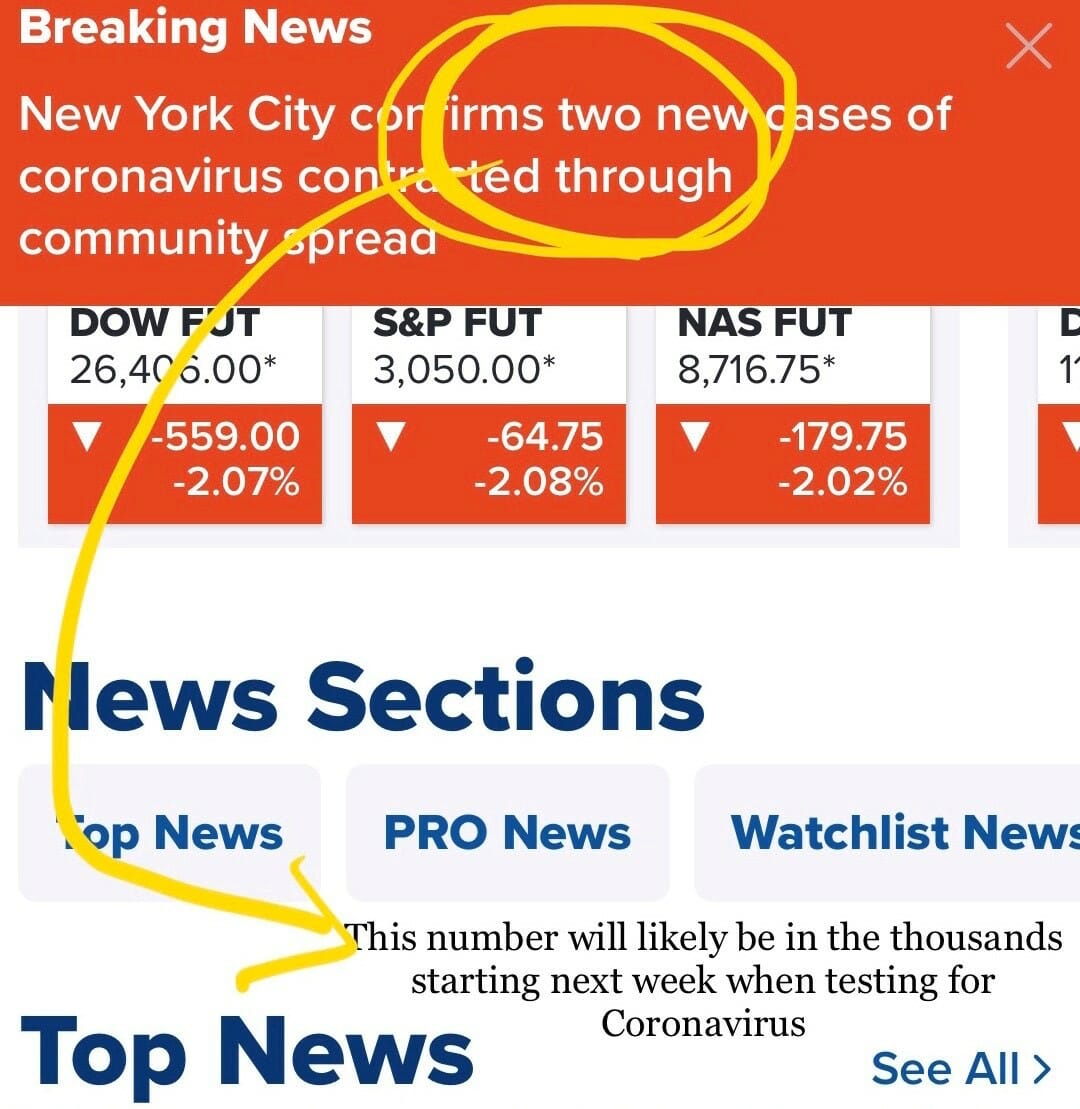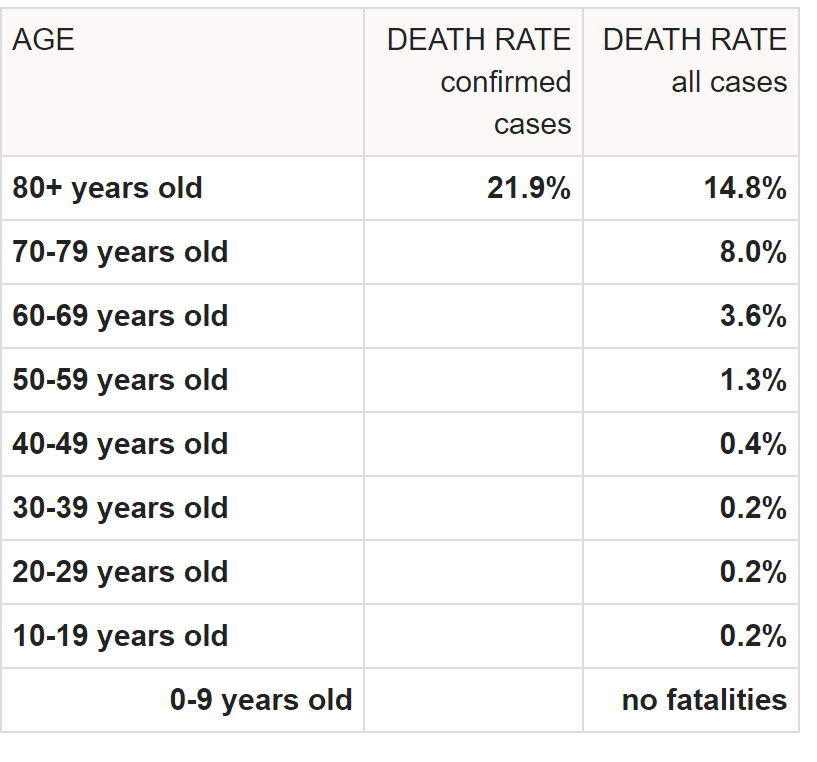Special ‘Money Matters with Wes Moss’ podcast on this research can be found on all podcasting platforms.
Today the media is propagating a 3.4% mortality rate for COVID-19. A brand-new research report citing Dr. Amesh Adalja from John Hopkins University says the rate is likely much lower. Dr. Adalja says that COVID-19 likely has a “sub 1%” mortality rate, which might even go as low as .1%-.5%. But so long as the public thinks that 3 out of 100 people will die from this, we will see a massive hit to commerce, consumer confidence, to the economy, earnings, and ultimately to the market. Once the narrative turns and the public becomes educated on the real danger of COVID-19 (which is far less than the headlines are saying right now) the fear factor will recede, and we will go back to business as usual. I think having this brand-new research and perspective is a complete game-changer for the Coronavirus narrative.
Right now, the narrative is, “The world is about to shut down like China did, meaning a global and US recession. This is terrible for stocks.” I believe that narrative to be short-sighted and false. It’s our job to help you gain an objective perspective rather than the panic we’ve been seeing.
Coronavirus
While viruses are always scary, what we all really want to know is, “Doc, what are my chances of surviving this?”
The mortality rate is the king of all statistics here. The absolute most critical number to figure out. It’s the difference between sheer panic and an economic shutdown, and “hey, let’s go with business as usual.”
Thanks to the coronavirus, I think we’ve gotten a sense of what number disrupts business as usual. It’s 2%. That has been the prevailing number reported in the media. Two percent mortality, or as my doctor calls it “the kill rate.” A 2% kill rate for a virus that we can pick up very easily is enough to stop commerce. We have stopped flying to China and have travel warnings for other countries like Italy and Iran.
All week long there have been headlines of cancelations: the Exxon conference in Houston with attendees from 80 countries, Google’s annual developers conference, The Louvre in Paris, the Disney+ press launch in Europe, Ford Motor Company, Greenday’s Hella Mega Tour, filming in Italy of Mission Impossible 7, and Japan has even threatened to postpone the Olympics.
Clearly, 2% is a number scary enough to make you change your behavior.
Changed behavior = stay home = economic pullback and maybe even recession. So, of course, the market is freaking out.
But, it all comes down to the fear surrounding the question I posed earlier. “Doc, what are my chances of surviving this?”
That’s where we are starting to get some very powerful insight around this subject.
Spoiler alert, 2% is a misleading number. A misleading number that is pumping more fear into the general public and markets than reality.
Now, I’ve been searching high and low to get in front of this, and the most recent data on this from arguably the highest credibility resource possible is from a board-certified infectious disease doctor from John’s Hopkins University.
Dr. Amesh Adalja is from the Johns Hopkins University Center for Health Security. Just this week he shared his views on a research call. I then reviewed his findings and comments with my other resources in the Public Health system, like the CDC. Asking the question, do my other expert resources agree with Dr. Adalja!?
The answer is yes. Absolutely.
So let’s get right to the mission-critical question of “Mortality Rate”
Dr. Adalja believes the case fatality rate is below 1% and will likely drop further once pervasive testing is broadened to find mild cases. This could take the rate to as low as .1% to .5% – remember this is a simple numerator/denominator calculation.
- If we have 100,000 cases (the denominator), and 2,000 fatalities (the numerator), that’s a 2% rate. But what if, and there is wide agreement that COVID-19 has been spreading since November of 2019, there are 1,000,000 cases? Well, now the rate is 0.2% because now the equation looks like 2,000/1,000,000!
Of course, to really find this number we need to have a more accurate count on the number of people infected with COVID-19.
Need for greater testing – As of the time I’m publishing this article, testing has only been for potential travel-related cases that came here to the U.S. That’s going to skyrocket next week with likely 1.5 million test kits in the US. Thank you, Vice President Mike Pence. Once we have very broad testing then we can really see the numbers.
When it comes to the mortality rate, there’s wide agreement that the number is sub 1% and could end up much lower than that. I’m not using the flu numbers to diminish COVID-19, but they are important to gain perspective.
- 2017/2018: 44.8M people in the US got the flu
- 7M went to the doctor = 46%
- 808k were hospitalized = 1.8%
- 61k died = Mortality rate of .14%
What we’re finding out now is that COVID-19 mortality rates, which are trending towards sub 1%, and could be in the .1 to .5% range. This means we have another flu. Let me repeat that again. Another flu.
It’s NOT good news, but it’s also something that doesn’t stop this economy in its tracks or even slow it down for very long. Has it been a temporarily bad quarter in the US? Yes. Absolutely. But my feeling now is that at some point, and I would say sooner not later here, the prevailing thought will go from, “I don’t want to leave my house,” to “okay, business as usual. But I better wash my hands and cover my mouth if I cough.”
There may be some weeks where the kids are out of school. But this is NOT a scene from the movie “Contagion.” And it’s certainly not “I Am Legend” with Will Smith.
Age Does Make A Difference
Let’s take a look at the age brackets:
Chart source: worldometer
Just like the flu, it’s worse for older generations.
The mortality rate for COVID-19 is very low for youth, worse if you are 60, 70, and particularly scary if you’re 80+. So, from a health perspective, the older you are the more precaution you will need to take. But, from what I can discern from the medical community, it’s likely the overall impact is far less than what was initially reported on this.
While I fully expect the number of COVID-19 cases to increase dramatically over the next few weeks as we ramp up testing, However, I also believe this will coincide with the mortality rate dropping dramatically as well as the denominator will grow. Ultimately, I believe this mortality rate of COVID-19 will act more in line with a rough influenza season. On the bright side, Dr. Adalja believes that a vaccine could be available in less than a year. He highlighted several therapeutic options that could help treat infected patients, and he believes data on those treatments could be available over the next few months.

COVID-19 is scary and rough
That said, we will get through this. Right now, I believe the narrative around COVID-19’s mortality rate is at its peak and will only get better from here. And likely sooner rather than later.
To listen to this special report along with some additional commentary around Super Tuesday, click here. I’m following this and other breaking news impacting the market and US economy. If you’d like to stay up to date with the latest news and research from me and my team at Money Matters, be sure to subscribe to my podcast on your favorite podcasting platform.


